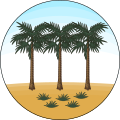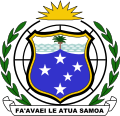Coat of arms of Samoa facts for kids
Quick facts for kids Coat of arms of Samoa |
|
|---|---|
 |
|
| Armiger | Independent State of Samoa |
| Adopted | 1962 |
| Motto | Fa'avae i le Atua Samoa "God be the Foundation of Samoa" |
The coat of arms of Samoa is the official symbol of the country. It was inspired by the United Nations (UN). This is because New Zealand helped govern Western Samoa for many years.
First, it was a League of Nations Mandate. Later, it became a United Nations Trust Territory. Samoa gained its independence on January 1, 1962. It was the first Polynesian nation to become independent in the 20th century. The background of the coat of arms has a grid pattern, similar to the UN symbol. Many parts of the coat of arms are also seen on Samoa's national flag.
Contents
What the Coat of Arms Looks Like
The official symbol of Samoa is also called the Public Seal of Samoa. It has a special design with several important parts.
The Shield
The main part of the coat of arms is a silver shield. The bottom two-thirds of the shield are blue. On this blue part, there are five silver stars. These stars represent the Southern Cross constellation. They are arranged in the same way as they appear on the Flag of Samoa.
The top third of the shield shows a green sea. From this sea, a green coconut palm tree grows. This tree is a common sight in Samoa.
Other Important Symbols
Above the shield, there is a gold cross. This cross sits on top of two circles that look like a map of the world. These circles are surrounded by olive leaves. This design is similar to the symbol used by the United Nations.
The coat of arms also includes a motto. The motto is "Fa'avae i Le Atua Samoa". This means "God be the Foundation of Samoa" in English. All these symbols are inside two outer circles. Between these circles, the words "The Public Seal of the Independent State of Samoa" are written.
History of Samoa's Coat of Arms
The coat of arms has changed over time as Samoa's history unfolded. Different versions were used during different periods of the country's past.
See also
 In Spanish: Escudo de Samoa para niños
In Spanish: Escudo de Samoa para niños





